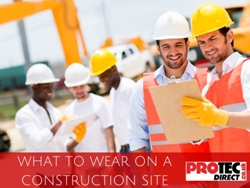Construction sites are dangerous places. With heavy machinery, temporary structures, working at height, often with dangerous materials, the potential for accidents is great. So, if you work on or visit construction sites regularly, it’s important that you know what you should be wearing to protect yourself.
Workplace laws put in place by the Health & Safety Executive dictate what you must wear on a construction site – and these should be backed up by the approved attire of each site. Most sites will have their dress code prominently displayed so that everyone understands what is required.
But what clothes and personal protective equipment should you wear on site? This blog will cover exactly how you should dress to protect your skin, limbs, head, and eyes from potential risks.
Feet
With so many heavy loads moving around, your feet and specifically your toes are almost always at risk on a work site. However, toe-capped boots will protect your feet from heavy objects or collisions, keeping them safe from injury.
Appropriate boots are also recommended because of the unsteady ground that often comes with construction sites, meaning strong soles and ankle support are necessary. Waterproof boots can also prevent water penetration and excessive cold causing discomfort. Our collection of protective footwear is ideal for all types of workers.
Wearing the correct socks is also important, especially in colder weather. Lots of thin layers or specific thermal socks are recommended to prevent excessive cold damaging toes.
Legs
While shorts may be a good idea in extreme heat, they are generally not recommended on building sites or in warehouses, as they leave skin exposed, and therefore unprotected. A pair of tough, hard-wearing trousers are usually more suitable and employers should also consider buying knee pads for their workers – to be worn over the trousers to provide further joint protection.
If a job requires that workers are on road-work sites overnight or in low light, hi-vis trousers are a must. Paired with a hi-vis jacket and hard hat, workers will be able to continue working to the best of their ability without being in danger of being missed by passing motorists. For workers that continually work outdoors in all weather conditions, a good quality pair of waterproof trousers could be crucial to their comfort and productivity.
Body
Keeping warm and dry at work is the number one priority, as discomfort will decrease productivity and increase the likelihood of an incident. Wearing thermal clothing such as base, mid, and top layers will trap heat and insulate the body.
In wet conditions, a waterproof jacket is recommended, but make sure that it’s breathable so that it is easy to work in. Depending on personal preference or temperature, t-shirts and polo shirts may have long or short sleeves.
All workers on site are required to wear a high-vis vest. As there’s often a significant amount of machinery and heavy materials around, it’s essential that you stay as visible as possible to avoid any accidents.
Hands
A solid pair of gloves is recommended and required for a lot of jobs on construction sites and warehouses. Gloves will protect the hands from chemicals, cuts and burns, but also offer excellent friction grip when handling metal or other work equipment.
There are many different types of gloves available, depending on the work being carried out. Protec stocks a range of anti-vibration gloves, grip gloves, heat resistant gloves, rigger gloves, and thermal gloves amongst others.
Head
The number one rule for anyone working on or visiting a construction site is that a hard hat must be worn at all times – this is a legal requirement. The colour of the hard hat that you wear indicates your role on the construction site, and visitors to the site wear a separate colour so it’s clear who’s an employee and who’s not.
Other protective equipment
As well as the personal protective equipment and clothing mentioned above, there is some other task-specific protective equipment that is often required. Safety goggles and breathing apparatus (including standard face masks and full respirators) will be necessary for some of the nastier jobs on site. These offer valuable protection to sensitive areas of the body.
Also, for those working at height, a safety harness may be required. Limb protectors and shin guards may also be necessary when using certain power tools.
Staying safe on site should always be your number one priority. Dressing appropriately and making sure you are always wearing the correct safety apparel is the first line of defence.





Leave a comment